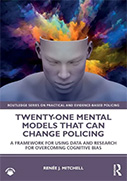Twenty-One Mental Models that can Change Policing

Author: Renée J. Mitchell
Publisher: Routledge, 2021. 228 pages.
Reviewer: Valerie Clodi | December 2022
Renee J. Mitchell’s book, Twenty-One Mental Models That Can Change Policing, is undoubtably one of the must-read law enforcement books of 2022. The book dives into evidence-based policing and provides frameworks for any police agency to implement in their departments. Drawing from 21 different mental models, along with examples that are thoroughly explained on how to implement each one, this book explores what evidence-based policing is, why it is important to rely on evidence-based training, and how law enforcement can achieve and implement evidence-based policing in their own departments.
Lawrence W. Sherman was one of the first pioneers in evidence-based policing and built it from the concept of “evidence-based medicine.” Sherman defined evidence-based policing as using the best available research on law enforcement in order to create and implement guidelines, training, and to evaluate police agencies, units, and officers. Simply put, it shifts from the old mindset of “best practices,” “we have always done it this way,” or as Mitchell explains, “I know a guy,” to a ”new” way of thinking: using the most proven methods and research, with the least amount of harm to the public and communities, to shape and build police departments.
Framing this new way of looking at complex problems and deep-diving into them by conducting research in order to find the best solution, Mitchell first closely examines evidence-based policing within the system 1 and system 2 thinking styles developed by Dr. Daniel Kahneman. In Thinking, Fast and Slow, Dr. Kahneman describes system 1 as being the quick and automatic thought processes that have little voluntary control, while system 2 is the more complex compilations that require attention and effortful mental activity. Mitchell is able to piece these concepts together alongside their relevance to evidence-based policing in such a way that supports new ways of thinking about policing and better alternatives to problem-solving in law enforcement.
Another concept Mitchell explains is Bayesian reasoning, an application of deductive reasoning, and its role in evidence-based policing. Bayesian reasoning is the probability of an event, A, occurring, given if another event, B, has occurred. This probabilistic model essentially states that the probabilities of both prior and new knowledge are needed to see if something is true or not. Mitchell explains that basing decisions on probability, rather than knee-jerk reactions, is more likely to be successful, as compared to just “doing something.”
Mitchell also discusses the role and relevance of research methods to evidence-based training. She states that correlation is not causation, and this can shed light on incorrect assumptions. Also, by only looking at small amounts of data and generalizing from them, can create, rather than resolve, many problems. By “falling for” the conclusions drawn from a small amount of data, this may provide excess “noise” and drown out the signal that the data may actually be providing. This can lead to actions or policies to address issues that may ultimately solve themselves with time, which can waste taxpayers’ money on solutions to problems that are not needed. As Dr. Laura Huey has stated in her book, Implementing Evidence-based Research: A How-to Guide for Police Organizations, you have to be willing to eliminate programs that are ineffective or inefficient, no matter how beloved the program.
Mitchell’s book is a great resource for police departments as they move to new ways of thinking that diverge from the “old school” model of knee-jerk reactions, untested theories, and worn-out ideas. In a world of “do something,” Mitchell’s book shows how law enforcement can move into the 21st Century by using more pragmatic approaches to training and policing in order to truly answer the modern challenges that police departments face today.
References
- Huey, L., Mitchell, R. J., Kalyal, H. & Pegram, R. (2021). Implementing evidence-based research: A how to guide for police organizations. Policy Press.
- Kahneman, D. (2011). Thinking, fast and slow. Macmillan. p. 20.
- Sherman, L. W. (1998). Evidence-based policing. Police Foundation. https://www.policinginstitute.org/wp-content/uploads/2015/06/Sherman-1998-Evidence-Based-Policing.pdf
Valerie J. Hebert-Clodi, PhD student, Department of Workforce Education and Development, at Southern Illinois University Carbondale.


